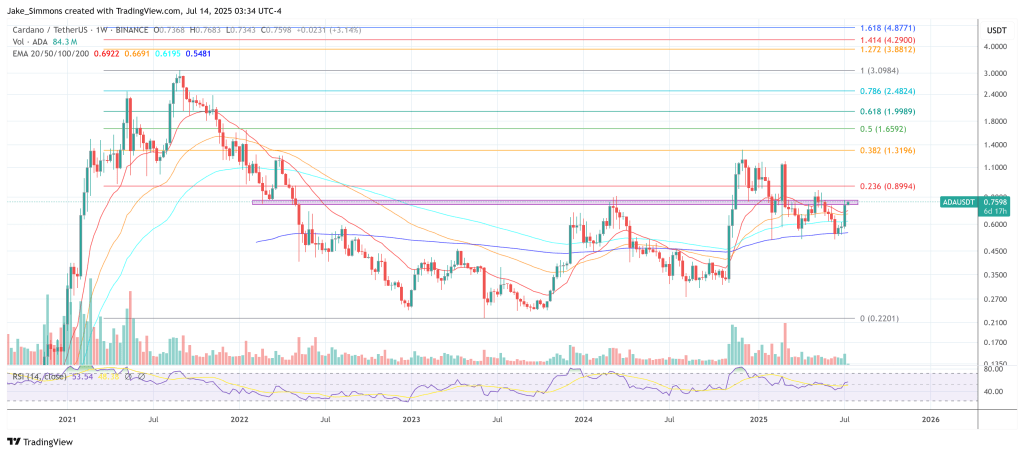Hoskinson Reveals: Cardano’s Bitcoin DeFi Vision Is Now Reality – No More Hypotheticals
Cardano founder Charles Hoskinson drops the mic—his blockchain's Bitcoin DeFi integration isn't just whiteboard scribbles anymore.
From Theory to Live Chain
The 'academic blockchain' finally gets its hands dirty. After years of peer-reviewed delays, Cardano's Bitcoin bridge is executing real DeFi transactions—no testnet training wheels.
Wall Street's Worst Nightmare
Decentralized finance just cut its last tether to traditional banking. Bitcoin holders can now earn yield without surrendering custody to those pesky (and profit-hungry) centralized exchanges.
PoS Meets Proof-of-Work
Cardano's energy-efficient network becomes Bitcoin's defi gateway—because even crypto OGs need yield farming options that don't burn a small country's worth of electricity.
One cynical footnote: Banks will still find a way to slap a 2% 'convenience fee' on this somehow.
Cardano Tech Goes Live on Bitcoin Mainnet
One of the most striking announcements came when Hoskinson confirmed that live transactions are already flowing between Bitcoin mainnet and Cardano mainnet. “We had demonstrated transaction between Bitcoin mainnet and Cardano mainnet where an ordinal was able to move back and forth,” he said. “It really proves not only the concept but it proves it at scale.”
Cardano’s role in this emerging stack, according to Hoskinson, is to serve as the computational layer to Bitcoin’s value and security layer. “Bitcoin is a very secure audit layer… cardano is an amazing computation layer. And when you pull these two pieces together and have a little toggle to go back and forth, we can allow a seamless experience,” he said.
This toggle—a major part of the user experience innovation—is designed to abstract away complexity for end users. “You have a switch, and you push the switch and it says DeFi mode,” Hoskinson explained. “No mention of another network, no mention of other things… All your transactions you pay fees in Bitcoin and all your returns you get back in Bitcoin.”
From a design philosophy standpoint, Hoskinson emphasized the importance of staying true to Bitcoin’s cultural and ideological core. He identified three rules that define legitimate Bitcoin DeFi: it must use Bitcoin for security, Bitcoin for fees, and return yield in Bitcoin. “Unless and until you’re able to present that experience, you’re kind of dead in the water philosophically, culturally, and technologically,” he said. For years, this was an unsolved problem. Now, according to Hoskinson, it isn’t.
The infrastructure stack, he said, is maturing rapidly thanks to contributions from Cardano-aligned partners like Fairgate, Sundial, and the Lace Wallet team. The toggle switch was first showcased during this year’s Bitcoin conference, and is already live in the Lace desktop wallet.
Hoskinson also revealed that Cardano’s development environment is being reused on Bitcoin via BitVMX. “We showcased… is there a path where Cardano programming language can be used to write Bitcoin script?” he asked rhetorically, before answering with live demos that included tools across both chains.
He emphasized that the model builds on Cardano’s foundational similarities with Bitcoin, from its UTXO model to its native assets system. “It just has all the things you always wished Bitcoin had,” he said, “but if you’re a Bitcoin developer, you’ll instantly get how Cardano manages.”
That compatibility extends to Cardano’s Babel fees mechanism, which enables users to pay transaction costs in currencies other than ADA—including Bitcoin. “So just like when a tourist goes to France and they pay with dollars and don’t even realize they’re spending euros… under the hood, there’s ADA being transacted, but the user doesn’t see it.”
Hoskinson also revealed ambitions for a Bitcoin-backed algorithmic stablecoin, building on Cardano’s experience with Jed and his early work with BitShares. “I’d love to do a Bitcoin-backed algorithmic stablecoin. That WOULD be incredible. It’s almost like the Bretton Woods agreement—you have gold-backed money, now you have Bitcoin-backed money.”
On the adoption curve, he believes the combination of user experience improvements, reduced fees, and clear trade-off control is critical. “You don’t pick the security model for the user—you let them decide,” he said, describing a UX LAYER where Bitcoin maximalists can toggle to a purist configuration, while others may prefer lower fees and faster throughput.
Hoskinson framed the entire initiative as part of a broader shift toward pragmatic cross-chain cooperation in crypto. “Bitcoin and Cardano kind of make each other better,” he said. “This is the changing of the ways in crypto. We’ve kind of buried the hatchet.”
And the scale is massive. “It’s four times larger than the market cap of Solana and ethereum combined,” Hoskinson claimed. “Bitcoin at this juncture, especially with the bull market coming, has almost unlimited liquidity. So it’s the ecosystem that really needs this.”
While Cardano has long pushed for this integration, Hoskinson made clear that the leap from vision to mainnet deployment changes everything. Cardano’s Bitcoin DeFi roadmap is no longer just theoretical—it’s alive, on-chain, and ready to scale.
At press time, Cardano traded at $0.7598.


